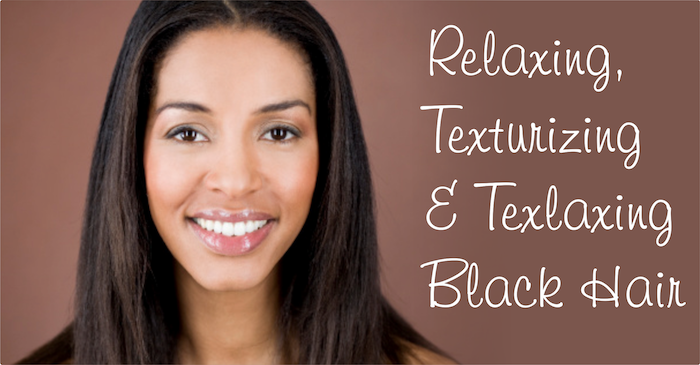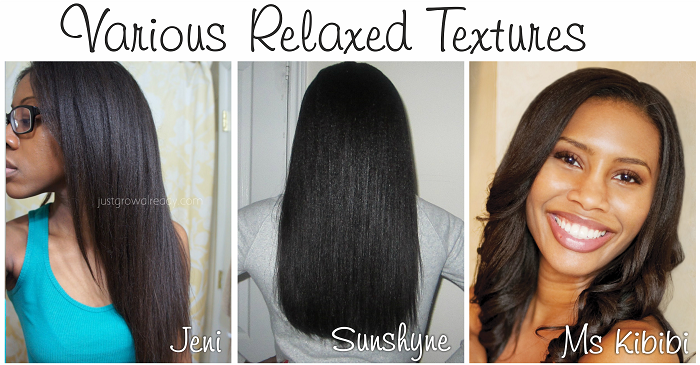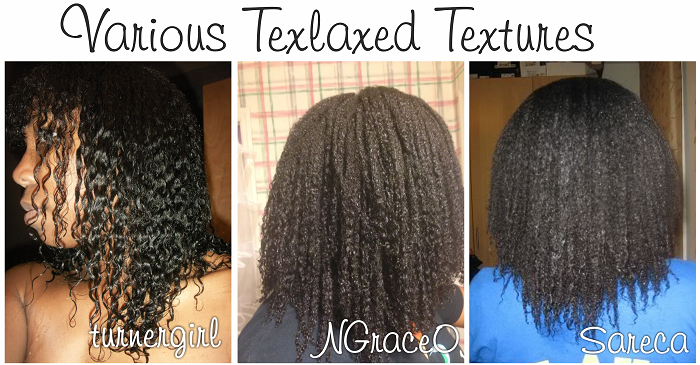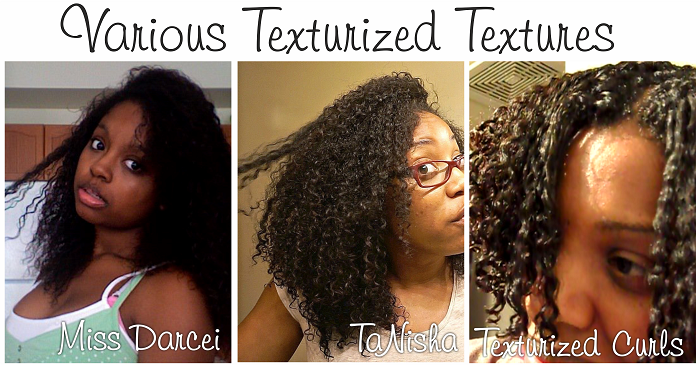
Which one is for you?
Relaxing, texturizing and texlaxing are in actual fact quite similar. All 3 involve the use of chemicals which are either Sodium Hydroxide based (lye), potassium* hydroxide, lithium hydroxide, or guanidine hydroxide based (no lye) or ammonium thioglycolate relaxers commonly known as ‘Thio relaxers’.
In essence all relaxers and texturizers penetrate the hair shaft causing it to swell and breaks it’s internal bonds which changes the hair texture from curly to straight. While all three processes are pretty similar, the length of time the chemicals are left in the hair and the type of chemical used, determine whether the hair is relaxed, texlaxed or texturized.
Determining which process is best for your hair depends on a number of factors. Mainly:
The health of your hair and scalp
Chemical treatments should only be applied to hair that is healthy with no scalp issues evident.
The porosity of your hair
High porosity hair absorbs much faster than normal or low porosity hair. Relaxers as a rule tend to increase the porosity of hair strands so if your hair is already high porosity to begin with, a relaxer may damage your hair beyond repair leading to major breakage. In this case gentler treatments like texlaxing or texturizing may be your best option.
The thickness of your strands
If your individual hair strands are fine then they may be unable to withstand a full relaxer process, this is a common reason why some women experience breakage when they relax their hair.
A strand test must always be performed before attempting to process the hair with any chemical. This tells you or your stylist the ideal processing time for the result you are looking to achieve.
Bear in mind that a person may have a variety of textures on their heads which may require a different processing time for each section. This avoids any over or under – processing of the hair.
First off: Relaxing…
Relaxing

Relaxing hair involves the use of a Sodium Hydroxide hair relaxer (Lye Relaxer) which is the strongest and gives the most dramatic effect or a Guanidine Hydroxide hair relaxer (No Lye) which is considered healthier for hair based on its lower alkalinity.
The relaxer is applied to the hair in sections then smoothed through with the fingers or with a comb until the desired level of straightness is achieved or until the processing time elapses.
The relaxer is then rinsed off thoroughly and then washed multiple times with a neutralizing shampoo which stops any more relaxer action which could over-process the hair. Relaxed hair tends to be either bone straight or with a slight curl when wet that then dries straight depending on the method used.
Pros of a relaxer:
- Easier detangling of the hair as hair can be combed easily without much pulling or tugging.
- Many like the look of ‘bone straight’ hair.
- More variety with sleek straight styles without having to use much heat
Cons of a relaxer:
- Notoriously difficult to maintain length without the use of many products to strengthen the now weakened hair
- Breakage begins if hair is not constantly conditioned to alleviate the inherent dry condition of the newly porous hair.
- Touch ups required every 10+ weeks to keep the hair (especially around the edges) sleek and straight which can become quite expensive
- Hair lacks body – tends to look a bit flat when first relaxed but can gain back a bit of body as time goes on.
And now a video demonstration on the relaxing process.
Next up: Texturizing…
Texturizing

Generally this utilizes a very mild form of a relaxer called a texturizer which is processed according to the guidelines of the product. The aim of this is to soften the hair texture leaving it with ‘looser’ curls or waves but leaving much of the volume in the hair.
Many women who texturize their hair will tend to continue to wear ‘natural’ hairstyles like wash and go’s, twist outs and braid outs but enjoy the softer easier to detangle hair that texturizers give them.
The texture of the hair after the texturizer depends a lot on the initial curl pattern of the hair. Large corkscrew curls will become S-shaped curls after a texturizer, tighter curls will look loosened and hair but may not have a definite curl pattern. Most common result as time goes on is that hair gets progressively straighter.
Pros of a texturizer
- Easier detangling of the hair as the texture has been softened
- May impart more of an even curl pattern to those who haven’t got it while leaving a lot of volume in the hair
- Less frizz is experienced with the curls left in the hair
- Less shrinkage is experienced
- Easier to style – straighten etc as hair does not revert very quickly
Cons of a texturizer
- As the hair has been chemically treated, constant conditioning and protein treatments are required
- Breakage may ensue if not taken care of properly
- Touch ups are necessary. They are not required as often as with a relaxer but would still be needed to keep the look
- If care is not taken during the touch up of the texturizer, the ‘run off’ when rinsing the chemical out could make the previously texturized hair turn straight so its not uncommon to find a multitude of textures including straight ends on people who texlax.
And now a video demonstration of texlaxing:
And finally: Texlaxing
Texlaxing

This is a term that was coined in hair forums and is done more or less the same way as a texturizer in that it aims to loosen the curl pattern of natural hair except that it uses a relaxer chemical instead of a texturizing one to achieve the result.
The relaxer chemical will then have oils*, conditioner, protein or a combination thereof added to it to make it less potent, this is applied to the hair the same way as a relaxer. Again this is left in the hair for much less time than the recommended amount to achieve the looser curl pattern and usually the chemical will not be ‘smoothed’ through the hair to avoid the hair being inadvertently straightened.
The aim of texlaxing is to loosen the natural curl pattern of the hair but leave a lot of the natural elasticity in the hair for strength. While texturized hair tends to look quite similar to texlaxed hair it can vary widely depending on the degree of curl left or the texture of the hair before the chemical is applied. 3c texlaxed hair looks very different from 4c texlaxed hair and while 80% texlaxed may look just slightly wavy, 40% texlaxed will look just like texturized hair.
Pros of texlaxing
- Easier detangling of the hair as the texture has been softened
- Gives variety as depending on the curl left behind, hair can be worn in a ‘wash and go’ style
- Hair still has a lot of it’s elasticity left behind so is less prone to breakage than relaxed hair
- Easy to style as you are still able to achieve a sleek straight look with heated tools without hair reverting quickly.
Cons of texlaxing
- The hair has been chemically treated so constant conditioning and protein treatments are required
- Breakage may ensue if not taken care of properly
- Touch ups are necessary but may not be required as often as with a relaxer depending on the amount of curl left in the hair
- Similar to texlaxed hair, texturized hair may also struggle with chemical run off during the rinsing process which may lead to ends having progressively looser textures eventually becoming straight as time goes on
And below is a video demonstration of the texturizing process:
https://www.youtube.com/watch?v=t1C5uE3Bw1g
With this information you can choose which process will best suit your hair and give you the desired results. As always, the health of your hair should not suffer for the style! See the article on how to stop relaxed hair from breaking.
Can I do the texlaxing method with a texturizer? Or how to go from texturized to texlaxed hair?
I need more help on how to texlax my hair. I just took my hair out of braids and its been awhile since i last permed my hair so there isnt much perm left and i was wondering if somebody can tell me how to do it step by step..I tried watching other people's videos but they act like it'll kill them to open their mouth and talk so im kinda lost..Can anybody help me?
The Real Person!
This lady has 3 videos on how she does her texlax. She's pretty thorough and you can see all she does: https://blackhairinformation.com/hair-care-videos/… https://blackhairinformation.com/hair-care-videos/… https://blackhairinformation.com/hair-care-videos/…
Dear Alma, I had my hair relaxed five months ago and am on braids for 2 months, I am thinking of going natural but do not want to cut off my 16 inches hair. Can I use a texturizer to make it soft for transition as I cannot endure the pains of my harsh hair texture. Where can I get to buy texturizers in Poland? Thanks.
The Real Person!
Hi Rita, texturized hair is just a mild relaxer but isn’t natural. If you are really serious about going natural then you will have to not only get used to your natural texture but start loving it too! You can soften any coarse texture through regular deep conditioning and you don’t have to cut off all your hair at once, you can transition slowly using braids or other protective styles and just trim the relaxed portion slowly. Read this post on transitioning to natural https://blackhairinformation.com/beginners/finding_a_regimen/transitioning-101-complete-guide-switching-relaxer-natural-hair-part-1/
Hi Alma!
So I have a short 4c TWA and sometime towards the end of Octoboer, I used a Pink ShortLooks texturizer on my hair to TRY and loosen up the curls, but it didn’t do much at all. Now, here we are towards the end of January and I’d like to get a relaxer and rock the short Eva Marcille type of cut. What would you recommend or what is some advice you have?
The Real Person!
I’m generally against mixing chemicals because of the risk of over processing. If you are looking to keep your hair short anyway then it’s not a big deal to relax over the texturizer (making sure that you use the exact same chemical) That is to say that if you used no lye to texturize then use no lye again to relax. If you used thio to texturize then you can’t have a relaxer at all because you hair will completely break off.
Now if you are looking at this short cut as a way to launch you to longer lengths then you won’t be starting on the right foot. It may not look like the texturizer did much but trust me, it did. Texturizers are recommended only to make your hair softer and easier to comb, they don’t give you any curl nor do they change your texture substantially. hth
Im just curious…can a person texlax their hair using a thio based perm. I ask because I have a dry curl and the double processing has taken a toll on my very fine hair. So, I figure if I can texlax it with the same chemical (thio based) which it does say it can be used as a relaxer as well, why not then? What are your thoughts?
I had my hair permed with Amla Legend Regular Relaxer By Optimum over a month ago. I’m want to put Texture My Way Organics Texture My Way No-Lye/No-Mix Organic Conditioning Texturizing System in my hair now. Love the texturize look. How much longer should I wait before doing that? Thanks.
Im just curious…can a person texlax their hair using a thio based perm. I ask because I have a dry curl and the double processing has taken a toll on my very fine hair. So, I figure if I can texlax it with the same chemical (thio based) which it does say it can be used as a relaxer as well, why not then? What are your thoughts?
I never had issues with relaxers and I only relaxed my hair every 16 weeks. My hair was actually really healthy. Going natural actually ruined my healthy relaxed hair. So I cut it off and now I am completely natural. It was a horrifying experience lol. But I like my natural hair. It is definitely a lot more work. I do miss my relaxed hair. It WAS almost waist length.
all same…
I hate natural hair it’s too time consuming and such a hassle. I am in a transitional period right now because im pregnant and put a perm on my hair that didn’t take. I’m scared to perm it now because my texture is so messed up but as soon as, I have her I’m putting a perm on. My permed hair was healthy and beautiful I never had the issue of damaged hair.
I textlaxed my hair for close to two years and it was horrible. My hair had all of these different textures. It was dry brittle and broke off everywhere. I have been transitioning to all natural since Sept 2013 and have a few inches of processed hair left in certain parts. I find it much easier to deal with my hair natural and I wear it straight not in its natural curl state. I also save a ton of money since I’m not buying a bunch of hair products.
I’m good